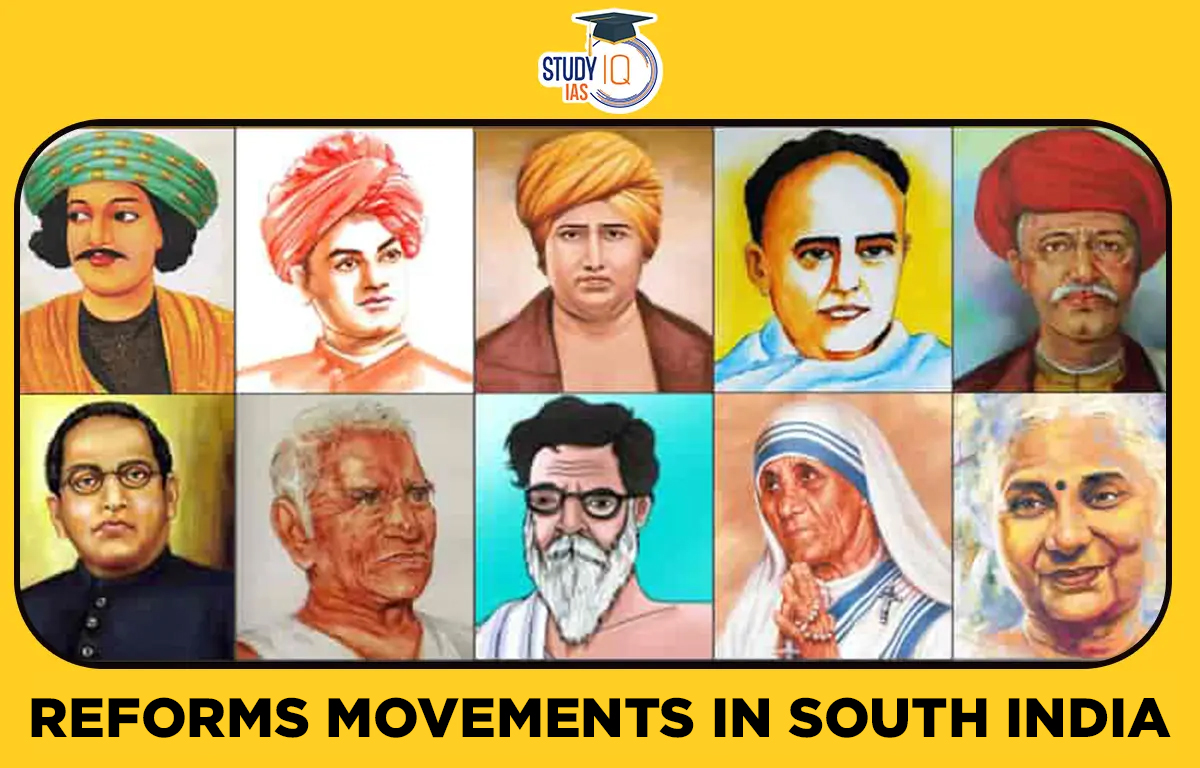Table of Contents
Reforms Movements in South India
Reform movements in southern India were influenced by a number of northern Indian movements, including the Brahmo Samaj, Arya Samaj, etc. In south India throughout the colonial era, various socio-religious reform movements have emerged. It aimed to change the caste-based, affluent, and repressive Indian society.
Some of the prominent leaders of the reform movements in southern India were Chembeti Sridharalu Naidu, Narayan Guru, and Kandukuri Veeresalingam. This article will highlight the socio-religious reform movements in south India during colonial times which are important for aspirants preparing for the UPSC examination.
Read More: Servants of India Society
Reforms Movements in South India History
The movements for social and religious change expanded throughout India from Bengal. The Brahmo Samaj served as a model for the Veda Samaj, which was founded in Madras in 1864. It pushed for the abolition of caste distinctions as well as the encouragement of widow remarriage and girl education. The Veda Samaj, like the Brahmo Samaj, promoted faith in a single ultimate God while denouncing the superstitions and rituals of traditional Hinduism.
The most notable figure in the Veda Samaj was Chembeti Sridharalu Naidu. He rendered Brahmo Samaj’s works into Tamil and Telugu. A few cities in Tamil Nadu, Karnataka, and Andhra Pradesh later saw the establishment of the Brahmo Samaj of South India and its branches. Soon after, Prarthana Samaj branches were also established, and the two Samajs collaborated to further religious and social reforms.
Kandukuri Veeresalingam was a notable figurehead for the reform movements in southern India. He was born in Andhra Pradesh in 1848 to traditional Brahmin parents. He committed himself to the cause of social reforms and was influenced by the Brahmo Samaj’s beliefs, especially those of Keshab Chandra Sen.
He founded a Telugu periodical in 1876 that was nearly entirely focused on social issues. His greatest contribution was to the movement for women’s independence. This included encouraging widow remarriages and girl education.
Read More: Satyashodhak Samaj
Reforms Movements in South India Types
1. Veda Samaj
The Brahmo Samaj served as the model for the 1864 founding of Veda Samaj in Madras. It promoted the abolition of caste distinctions, widow remarriage, and the advancement of girl education. Chembeti Sridharalu Naidu contributed to the growth of this movement by translating Brahmo Samaj works into Tamil and Telugu. In some towns in Tamil Nadu, Karnataka, and Andhra Pradesh, various branches of the Brahmo Samaj of South India were created.
2. Kandukuri Veeresalingam Reforms
Kandukuri Veeresalingam carried out reforms in support of the emancipation of women, encouraging girl education and widow remarriage, among other things. He committed himself to the cause of social changes after being influenced by the Brahmo Samaj’s views. In 1876, he founded a Telugu periodical that was nearly entirely devoted to social reforms.
3. Shree Narayan Guru Dharma Paripalana (SNDP) Movement
Conflict between the lower and upper castes gave rise to a number of regional movements, including the Shree Narayan Guru Dharma Paripalana (SNDP) Movement. It was established by Sree Narayana Guru Swamy (1856–1928) among the Ezhavas of Kerala, an underprivileged community of toddy-tappers who were forbidden from receiving an education and entering temples.
Several backward class movements emerged throughout the time leading up to independence. Because they believed that Brahmanas in particular monopolised much of the socioeconomic benefits, leaving the agricultural intermediate castes and communities in the dark, the backward classes came together against them.
4. Vokkaligara Sangha
The Vokkaligara Sangha began the Anti-Brahmin Movement in Mysore in 1905. The Vokkaligas made up the largest community in the formerly royal state of Mysore. The word “Vokkaliga” is derived from the verb “to thresh,” which means to separate grains from crops.
In India, caste is a system of social stratification and an identity-building tool. Indian culture was caught in a web of religious dogma and bigotry in the nineteenth century. Hinduism had become a composite of magic, animism, and superstitions, as had all other religions.
5. Self Respect Movement
In 1925, E.V. Ramaswamy Naicker (commonly known as Periyar), a Balija Naidu, started the Self-Respect Movement. Naicker considered the brahmanical religion and culture as the main means of exploiting the lower castes; hence the movement’s aim was to reject it.
It was an egalitarian movement that pushed for the end of Brahminical hegemony, equal rights for women and underprivileged groups, and the revival of Dravidian languages including Telugu, Tamil, Kannada, and Malayalam. To protest the prohibition on their admission into temples and other such restrictions, depressed castes formed multiple satyagraha activities throughout India.
Read More: Ramakrishna Mission
Reforms Movements in South India UPSC
The Brahmo Samaj, Arya Samaj, and other northern reforms movements serve as models for the Reform Movements in Southern India. The most well-known leaders of the reform movements in Southern India were Chembeti Sridharalu Naidu, Narayan Guru, and Kandukur Veeresalingam.
In southern India, a number of socio-religious reforms that were promoted changes to Hindu temple customs. They supported dismantling the Devadasi system that was intertwined with the temples. They argued for giving the public control over the wealth of the temples rather than allowing the priests to collect it.
Read More: Dharma Sabha


 Story of Meera Bai and Her Devotion For ...
Story of Meera Bai and Her Devotion For ...
 Desert Climate, Distribution, Climatic C...
Desert Climate, Distribution, Climatic C...
 Deserts of India Map, Features of Thar D...
Deserts of India Map, Features of Thar D...





















